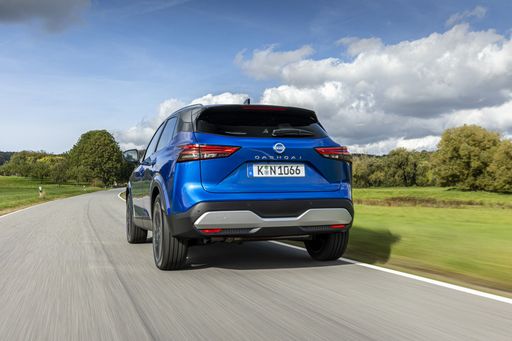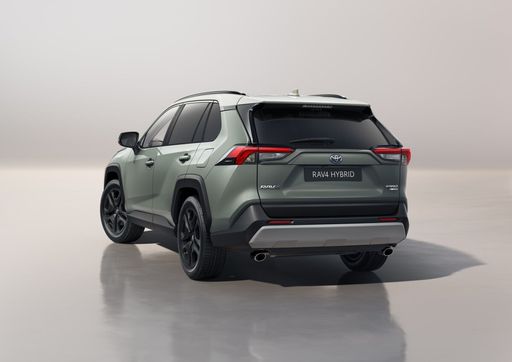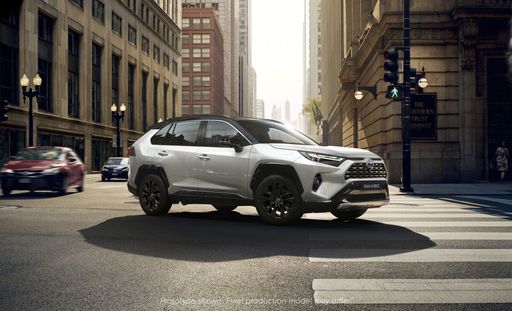The automotive market is constantly evolving, and when it comes to the compact SUV segment, two prominent players stand out: the Nissan Qashqai and the Toyota RAV4. Both vehicles offer a blend of style, performance, and practicality, making them attractive options for daily commutes and adventurous outings. In this article, we’ll compare these two vehicles based on various technical aspects and innovations.
Nissan Qashqai vs Toyota RAV4 – Differences & prices compared
Compare performance, boot capacity, efficiency and price at a glance.
Find out which car is the better choice for you – Nissan Qashqai or Toyota RAV4?
Design and Dimensions
The Nissan Qashqai measures 4425 mm in length, 1835 mm in width, and 1625 mm in height, providing a compact yet spacious interior for five passengers. The Toyota RAV4, on the other hand, boasts larger dimensions with a length of 4600 mm, width of 1855 mm, and height of 1685 mm. This makes the RAV4 slightly bulkier, offering a more assertive road presence.
Powertrains and Performance
Under the hood, the Nissan Qashqai offers a range of petrol engines, including a petrol MHEV and a full hybrid option. Power outputs range from 140 HP to a robust 190 HP, allowing for a spirited driving experience. The available transmission options, including a manual gearbox and a CVT, give drivers flexibility, while the available all-wheel-drive system enhances capability.
In contrast, the Toyota RAV4 is developed with a focus on hybrid technology, with power outputs of 218 HP to 306 HP in its various configurations. The RAV4 exclusively features automatic transmission, paired with a well-regarded CVT system, ensuring smooth acceleration. The RAV4 also impresses with its fuel consumption, as low as 5.6 L/100km, promoting efficiency without sacrificing power.
Acceleration and Driving Dynamics
For those who appreciate rapid acceleration, the Qashqai can reach 0-100 km/h in as little as 7.9 seconds, depending on the engine choice. This competitive performance aligns well with its stylish appeal. Meanwhile, the RAV4, particularly in its sportier variants, can achieve 0-100 km/h in an impressive 6 seconds, showcasing its performance credentials.
Interior Space and Trunk Capacity
Both SUVs are designed with practicality in mind. The Qashqai offers a trunk capacity of 504 L, while the RAV4 takes the lead with 580 L, making it more suitable for families or those requiring extra storage for gear or groceries. Both models host five seats, ensuring comfort for all passengers.
Technological Innovations
Nissan has equipped the Qashqai with advanced safety and connectivity features, including ProPILOT Assist and a modern infotainment system. With its driver-centric layout, the Qashqai aims to enhance the overall driving experience.
On the flip side, the Toyota RAV4 embraces hybrid technology further with its plugin hybrid variant, offering an electric range of up to 75 km, making it an appealing choice for eco-conscious consumers. The RAV4 also excels in safety features, boasting a comprehensive suite of Toyota Safety Sense technologies.
Efficiency and Environmental Impact
In terms of CO2 emissions, the Nissan Qashqai ranges from 116 g/km to 154 g/km, placing it within a competitive class. The Toyota RAV4 takes this a step further with its hybrid systems, achieving as low as 22 g/km, particularly in its plug-in variant, catering to a growing demand for lower emissions.
Conclusion: Which SUV to Choose?
Choosing between the Nissan Qashqai and the Toyota RAV4 ultimately depends on individual needs and preferences. The Qashqai is ideal for those seeking a stylish, performance-oriented compact SUV with a range of powertrain options, while the RAV4 appeals to those prioritizing hybrid technology and extra space. Both vehicles promise reliability, comfort, and modern features, guaranteeing a satisfying ownership experience.
Here’s where it gets real: The technical differences in detail
Costs and Efficiency:
Price and efficiency are often the first things buyers look at. Here it becomes clear which model has the long-term edge – whether at the pump, the plug, or in purchase price.
Nissan Qashqai has a slightly advantage in terms of price – it starts at 29600 £, while the Toyota RAV4 costs 35100 £. That’s a price difference of around 5529 £.
Fuel consumption also shows a difference: Toyota RAV4 manages with 1 L and is therefore clearly more efficient than the Nissan Qashqai with 4.50 L. The difference is about 3.50 L per 100 km.
Engine and Performance:
Power, torque and acceleration are the classic benchmarks for car enthusiasts – and here, some clear differences start to show.
When it comes to engine power, the Toyota RAV4 has a clearly perceptible edge – offering 306 HP compared to 205 HP. That’s roughly 101 HP more horsepower.
In acceleration from 0 to 100 km/h, the Toyota RAV4 is noticeable quicker – completing the sprint in 6 s, while the Nissan Qashqai takes 7.60 s. That’s about 1.60 s faster.
In terms of top speed, the Nissan Qashqai performs a bit better – reaching 206 km/h, while the Toyota RAV4 tops out at 180 km/h. The difference is around 26 km/h.
Space and Everyday Use:
Cabin size, boot volume and payload all play a role in everyday practicality. Here, comfort and flexibility make the difference.
Both vehicles offer seating for 5 people.
In curb weight, Nissan Qashqai is clearly perceptible lighter – 1420 kg compared to 1745 kg. The difference is around 325 kg.
In terms of boot space, the Toyota RAV4 offers a bit more room – 580 L compared to 504 L. That’s a difference of about 76 L.
In maximum load capacity, the Toyota RAV4 performs somewhat better – up to 1690 L, which is about 243 L more than the Nissan Qashqai.
When it comes to payload, Toyota RAV4 to a small extent takes the win – 600 kg compared to 520 kg. That’s a difference of about 80 kg.
Who wins the race?
The Toyota RAV4 proves to be leaves the rival little chance and therefore becomes our DriveDuel Champion!
Toyota RAV4 is the better all-rounder in this comparison.
 @ Toyota Motor Corporation
@ Toyota Motor Corporation
Toyota RAV4
Nissan Qashqai
The Nissan Qashqai blends practical, family-friendly packaging with SUV styling that refuses to shout, making it a sensible and dependable choice for everyday life. It’s comfortable to live with, economical on the road, and neatly equipped enough to feel modern without ever feeling precious — perfect if you want crossover versatility without the drama.
details @ Nissan Motor Corporation
@ Nissan Motor Corporation
 @ Nissan Motor Corporation
@ Nissan Motor Corporation
 @ Nissan Motor Corporation
@ Nissan Motor Corporation
 @ Nissan Motor Corporation
@ Nissan Motor Corporation
 @ Nissan Motor Corporation
@ Nissan Motor Corporation
Toyota RAV4
The Toyota RAV4 feels like a sensible friend on the road, marrying dependable practicality with a dash of SUV personality that keeps daily driving from turning dull. Comfortable and easy to live with, it looks tough without shouting and quietly gets the job done — a sensible pick for buyers who want versatility without drama.
details @ Toyota Motor Corporation
@ Toyota Motor Corporation
 @ Toyota Motor Corporation
@ Toyota Motor Corporation
 @ Toyota Motor Corporation
@ Toyota Motor Corporation
 @ Toyota Motor Corporation
@ Toyota Motor Corporation
 @ Nissan Motor Corporation
@ Nissan Motor Corporation
|
 @ Toyota Motor Corporation
@ Toyota Motor Corporation
|
|
|
|
Costs and Consumption |
|
|---|---|
|
Price
29600 - 39900 £
|
Price
35100 - 55700 £
|
|
Consumption L/100km
4.5 - 6.8 L
|
Consumption L/100km
1 - 5.6 L
|
|
Consumption kWh/100km
-
|
Consumption kWh/100km
-
|
|
Electric Range
-
|
Electric Range
75 km
|
|
Battery Capacity
-
|
Battery Capacity
-
|
|
co2
102 - 154 g/km
|
co2
22 - 128 g/km
|
|
Fuel tank capacity
55 L
|
Fuel tank capacity
55 L
|
Dimensions and Body |
|
|---|---|
|
Body Type
SUV
|
Body Type
SUV
|
|
Seats
5
|
Seats
5
|
|
Doors
5
|
Doors
5
|
|
Curb weight
1420 - 1665 kg
|
Curb weight
1745 - 1910 kg
|
|
Trunk capacity
479 - 504 L
|
Trunk capacity
520 - 580 L
|
|
Length
4425 mm
|
Length
4600 mm
|
|
Width
1835 mm
|
Width
1855 mm
|
|
Height
1625 mm
|
Height
1685 mm
|
|
Max trunk capacity
1422 - 1447 L
|
Max trunk capacity
1604 - 1690 L
|
|
Payload
466 - 520 kg
|
Payload
390 - 600 kg
|
Engine and Performance |
|
|---|---|
|
Engine Type
Petrol MHEV, Full Hybrid
|
Engine Type
Full Hybrid, Plugin Hybrid
|
|
Transmission
Manuel, Automatic
|
Transmission
Automatic
|
|
Transmission Detail
Manual Gearbox, CVT, Reduction Gearbox
|
Transmission Detail
CVT
|
|
Drive Type
Front-Wheel Drive, All-Wheel Drive
|
Drive Type
Front-Wheel Drive, All-Wheel Drive
|
|
Power HP
140 - 205 HP
|
Power HP
218 - 306 HP
|
|
Acceleration 0-100km/h
7.6 - 10.2 s
|
Acceleration 0-100km/h
6 - 8.4 s
|
|
Max Speed
170 - 206 km/h
|
Max Speed
180 km/h
|
|
Torque
240 - 330 Nm
|
Torque
-
|
|
Number of Cylinders
3 - 4
|
Number of Cylinders
4
|
|
Power kW
103 - 151 kW
|
Power kW
160 - 225 kW
|
|
Engine capacity
1332 - 1498 cm3
|
Engine capacity
2487 cm3
|
General |
|
|---|---|
|
Model Year
2025
|
Model Year
2024 - 2025
|
|
CO2 Efficiency Class
E, C
|
CO2 Efficiency Class
D, B
|
|
Brand
Nissan
|
Brand
Toyota
|
Is the Nissan Qashqai offered with different drivetrains?
Available configurations include Front-Wheel Drive or All-Wheel Drive.
The prices and data displayed are estimates based on German list prices and may vary by country. This information is not legally binding.
